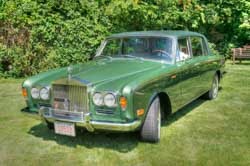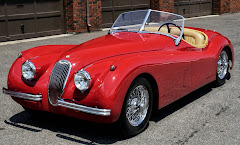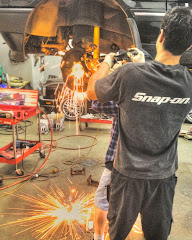 |
| 2017 Range Rover at Robison Service (c) JE Robison |
Timing chains have become a big problem on 2010 and newer Land Rovers, and on their sister Jaguars. The problem is widespread enough that there’s at least one class action lawsuit, and resale values have reportedly dived. Every week I hear from Land Rover owners seeking second opinions after being told they need a timing chain repair. Over the past few years, as preferred repair procedures have become more complex, repair estimates have risen from $5-6k to over $12k in major metropolitan areas.
Your engine might be developing cam troubles if clatter under the hood increases, or if you get an uneven idle; poor running; or check a engine light with high pressure fuel pump codes, intake manifold pressure codes, or cam timing codes. The most certain giveaway is a crankshaft-camshaft correlation fault. That fault tells you the cam can't be brought into phase with the crank (these engines have a means of fine tuning the cams.) The only causes of that fault are a failed adjuster, a skipped cam chain, or a stretched cam chain. All require engine teardown to repair, and two point straight to chain failure.
In extreme cases the cam chains slip enough to cause valve-piston collisions. Even if that doesn’t happen, all cam chain problems are serious. If you ignore them, you will end up with a ruined engine. To put that in perspective, a factory exchange engine for a 2012 Range Rover is $22,500 plus ancillary parts and labor.
This article explains the problem, how it arises, and what we do about it at Robison Service. We have been independent Land Rover service for 32 years, since Land Rover returned to North America in 1987. We’ve built a reputation for tackling heavy repair work on these trucks, and this is the latest engine to come to our attention.
Who is Affected?
In 2003, Land Rover entered into an agreement to install a version of the Ford AJ modular V8 in its upcoming LR3, Range Rover and other models. This engine replaced the BMW-sourced engine in the L322 Range Rover and the venerable pushrod v8 from the old Discovery. It proved to be an excellent design and was one factor in the huge success of newer models like the Range Rover Sport.
The engines earned a reputation for trouble-free performance through 2009. For 2010 the engine was redesigned with more displacement, Bosch direct injection, a new cam system, and other changes that boosted power significantly. Problems began appearing a few years later.
All Land Rover V8 engines made after 2010 are potentially problematic. We’ve seen a number of service bulletins addressing various aspects of this problem, but it’s not clear any of the bulletins heralds a definitive fix. At the least, I would say 2010-2016 motors are all at risk.
What is Happening?
The engines in question have three crankshaft driven chains. The innermost chain drives the high pressure injection pumps and oil pump. The middle chain drives the right side cams, as you face the engine (driver side in America). The outer chain drives the left cams.
 |
| Land Rover / Jaguar AJ V8 cam chains - post 2010. (c) JE Robison |
The chains are a high-strength design, and they are protected by tubes delivering oil spray lubrication to the highest load points on the crank gear. One weakness is in the tensioners, which are lightweight aluminum and plastic.
The cam chain tensioners have hard steel rams that wear into the guide rails. Over time the tensioners can jam in the holes, leading to loss of tension. The oil pump/injection pump chain guides are plastic with a spring steel tensioner that can weaken.
We’ve seen a couple modes of failure in these engines. The first is when the tensioners wear holes in the chain guides because the steel tension rams are harder than the guides. Land Rover addressed that sometime around 2014 with the addition of hardened steel caps on the cam chain guides. However, the engines still seem to have problems.
One concern we have is that, as of summer 2019, Land Rover had not updated the tensioner itself – just the guide rails. All we can do is hope the tensioners themselves are not part of the problem.
 |
| Tensioner and main guide rail for Land Rover AJ V8, 2012. (c) JE Robison |
If these engines are cranked over backward, by turning the crank pulley, the chain tensioners can collapse and the chains may skip time. Land Rover isn’t the only engine where that’s a concern, and turning engines backward is no exactly common. Furthermore, we have seen skipped chains on engines whose owners swear they were never manually turned backward. If correct, this may mean the tensioners are losing tension on their own, or it may mean the chains are losing their grip on the gears. Or both.
We have also seen slipped chains in engines whose the oiler tubes have been torn off by contact with the running chains. The only way that contact could happen would be for the chains to go slack on overrun, which again suggests tensioners are failing on their own. If an oiler lube (several inches long) got pulled into a timing gear, it’s not hard to imagine the chain slipping a few teeth in passing.
 |
| L-broken oiler tube. R-updated replacement oiler tube with guard |
It is also possible to get chain, guide, and gear failure when the oil breaks down and the chains stretch and wear. In some cases you have a clue to this by the sight of sludge and black debris under the covers. However we’ve seen chain stretch on engines that look clean, which tells us that lubrication failures are happening with oil that has not broken down into sludge.
We have photographs showing curves worn into chains and gears by 100,000 miles even in what we thought were well serviced motors. That leads us to question whether the factory spec oil is good enough, and whether what we thought was a conservative service interval is still too long.
 |
| The crankshaft drive gear and chains on a 2012 Land Rover AJ V8 |
 |
| Look closely - see where premature wear has reshaped the gear teeth |
 |
| 2010 Land Rover timing chain - contours "eased" by wear, making slippage more likely |
These engines originally ran a Castrol 5-20 Jaguar/Land Rover rated synthetic oil with a high performance filter. A few other makers are now supplying JLR rated oil; all are high end synthetics. We suspect the factory service interval is too long, having watched it move from 15k to 10k. At Robison Service, we have long recommended 7,500 mile intervals out of caution, having seen these lubrication failures in engines whose insides otherwise looked clean. Some people question whether that is low enough, and whether we should recommend 5 or 6k.
If you change the oil more often than necessary, your incremental cost is small and there is no other downside. If you don’t change the oil often enough to prevent engine wear, the only 100% would be a new engine, for almost $30k. On a 90,000 mile Rover, all the repair costs are going to be on you. How would you choose to bet?
We have looked at cam chains and gears, and we’ve observed the depth of engagement is lower on these newer chains that on the traditional bicycle or motorcycle type chains used before. The angle on the chain face seems to be less, and if tension relaxes even a bit, it may slip more easily. Looking at photos of chains we’ve removed we see evidence of that wear.
When the chains stretch you will get cam timing errors that won’t stay clear. These happen because the chain has stretched from wear. It's now too long, and the variable valve timing is unable to take up the slack. If the pump chain slips you will get high pressure pump codes because the cam won’t be in time with the crank anymore. That means the cam won't be pushing the pump when needed, so it won’t make enough pressure. Hence the fault. If the cam timing changes too much the intake vacuum will be affected and the motor will also show intake manifold pressure codes that won’t clear, in conjunction with cam codes.
These can be tricky to diagnose, because all those codes can appear for other (less serious) reasons, all of which must be ruled out before determining there is a cam chain problem.
What’s the Fix?
Prevention is the best course of action. Metal-on-metal wear is the cause of chain wear and failure. If we assume (or hope!) that the JLR specified oil is strong enough to prevent this when new, we might expect better protection if we change it earlier. Hence our advice to change oil at 7,500 miles, though that number is somewhat arbitrary and cautious owners might prefer a 5 or 6k interval.
Readers of my columns may note that I've written about timing chain issues on other car lines, such as Mercedes. On those engines we often saw chain wear in engines where there was extensive sludge buildup, which suggests the driver used "economy" oil in place of the recommended oil, and didn't change it often enough. The Land Rover engines we see are mostly clean inside, even with clear chain/guide failure.
Looking at the engine photos above you will note the designers have three oil jets aimed at the crank gear. Clearly that is the highest stress point for oil in this engine. Looking at my photo of worn components, you'll see the chain is now a "thicker" design as compared to the motorcycle type chains on the original version of this engine. I think one problem is that oil is not getting pushed into the chain and it breaks down under the repeated stress of passing through that gear. That takes us straight to stronger oil as a fix. The question is: Is the JLR specified oil too weak from the outset, or does the oil break down quickly in the engine?
Readers of my columns may note that I've written about timing chain issues on other car lines, such as Mercedes. On those engines we often saw chain wear in engines where there was extensive sludge buildup, which suggests the driver used "economy" oil in place of the recommended oil, and didn't change it often enough. The Land Rover engines we see are mostly clean inside, even with clear chain/guide failure.
Looking at the engine photos above you will note the designers have three oil jets aimed at the crank gear. Clearly that is the highest stress point for oil in this engine. Looking at my photo of worn components, you'll see the chain is now a "thicker" design as compared to the motorcycle type chains on the original version of this engine. I think one problem is that oil is not getting pushed into the chain and it breaks down under the repeated stress of passing through that gear. That takes us straight to stronger oil as a fix. The question is: Is the JLR specified oil too weak from the outset, or does the oil break down quickly in the engine?
Once the engine has damage, you’ll need repair parts. Both Land Rover and Atlantic British sell chain repair kits. To do the repair you will need a set of factory tools. The crank bolt is torqued over 500 foot-pounds and there is a holder for the pulley. There are tools to pin the engine and cams in proper place at top dead center, and a tool to set the chain that drives the high pressure injection pumps.
On later 5 liter engines the crank bolts are left hand thread. On earlier motors you’ll find right hand thread bolts. It’s important to identify which you have. The marks on the bolts tell the story. Left thread bolts are marked 12.9. The bolts are torqued to 148 foot-pounds and then another ¾ of a turn. The practice in Land Rover dealers is to replace the bolt any time it is loosened. We follow that rule here.
The special tools to service the cams and chains will run about $1,500. You’ll also need a full kit of workshop tools and a Land Rover scan tool to clear the codes. Those requirements place this repair beyond what most enthusiasts will want to undertake.
There is also an element of skill in doing the job, such that a shop that does a lot of these will have a better idea what to look for and get a better outcome in less time. Repair procedures are constantly evolving, and some of the older shortcuts (which some mechanics seem to still take) are not providing lasting repairs.
After review of several engines we think it’s wisest to change chains, crank gears, tensioners, and rails whenever this job is done. The factory has updated some of the oilers to make them more resistant to chain snags, and they should be changed too.
You can change cam chains with the engine in the car, though it is a big job. Most labor guides estimate 20 hours, but if you have damage, cleanup will consume more time, and if you skip the cleanup, more damage may occur later. If the oil pump and injection pump chain needs to be replaced the engine will have to come out, and the pan come off. That is more of a 40-hour repair.
We’ve seen a few engines with skipped timing on the pump chains. That worries us because we can retime the chain in the car, but we can’t change the chain or tensioner without engine removal and teardown. It may be that’s what it comes to on these motors, though. Time will tell.
This is a significant problem, one that will take up half a week to a full week’s labor, and several thousand dollars of parts. I wish I had a shortcut to offer you, but the shortcuts involve things like guide replacement without chain replacement, and I fear those fixes won’t prove sufficiently durable.
(c) 2019 John Elder Robison / J E ROBISON SERVICE
John Elder Robison is the general manager of J E Robison Service Company, celebrating 30 years of independent Bentley, Rolls-Royce, BMW/MINI, Mercedes, and Land Rover restoration and repair in Springfield, Massachusetts. John is a longtime technical consultant to the car clubs, and he’s owned and restored many fine British and German motorcars. Find him online at www.robisonservice.com or in the real world at 413-785-1665




























2 comments:
I assume this includes the AJ-126 supercharged V6 variant of the AJ V8 for timing chain issues?
excellent analysis!
Post a Comment